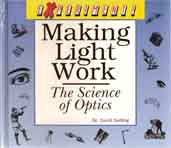MAKING LIGHT WORK: The Science of Optics - 5. Looking into Eyes
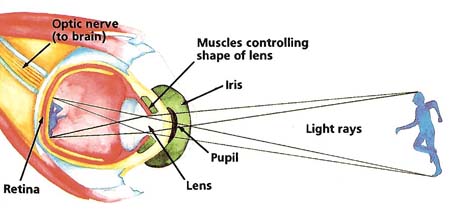
Figure 1. How the eye forms an image.
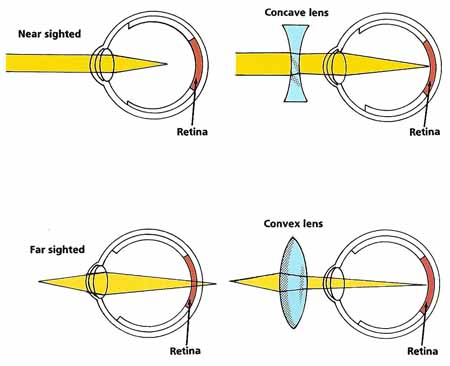
Figure 2. Corrective lenses for eyes.
Everyone is born with two very important lenses – the lenses of our eyes. Light enters the eye through a small round opening called the PUPIL. This is the black dot in the middle of your eye. Surrounding the pupil is a circle of muscle known as the IRIS. Colored chemicals in the iris give it various shades of brown, blue, or green. By altering the size of the pupil, the muscles of the iris control the amount of light that passes into the eyeball (see Figure 1).
Just behind the pupil is the lens. It is flexible like rubber, convex in shape, and small – about the size of your little fingernail. Light, falling on the lens, is focused to form an image on a sort of screen at the back of the eye called the RETINA. As you move your eyes from distant to near objects, your lenses are pulled from a thin shape to a fatter one by muscles that are attached to them. In this way, whatever you look at can be brought into focus, even though the distance from the lens to the retina stays the same.

Eye See!You will need:
What to do:
Partly darken the room, wait about a minute, and look into the mirror. Notice the size of your pupils. Shine the flashlight into one eye. What happens to the pupil of this eye? Notice the movement of the muscles in the iris around the pupil. Turn off the flashlight. How long does it take for your pupil to return to its original size?
Close one eye and hold this page in front of your other eye. Slowly bring the page closer and closer until you can only just see the words clearly. Hold the book in this position for a few seconds, then quickly look up at a distant object. What do you notice? Does the distant object seem clear right away? If not, how long does it take to come into focus? Try to explain the results in terms of what is happening inside your eye. How do you think this affects the ability of your eye to form clear images?
Caution: Eyes are easily damaged. Never press hard on them or stare
into bright lights. Never stare at the sun. Looking at the sun through
a magnifying glass, binoculars, or a telescope can cause permanent
blindness within a few seconds. |
Cameras and Eyes
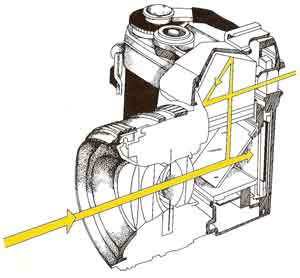 |
A camera works almost exactly like a human eye. It, too, uses a convex lens to focus images onto a light-sensitive surface.
And, just as the eye has a pupil, so the camera has an opening called an aperture that can be widened or narrowed to regulate the amount of light that passes through.

A Model EyeYou will need:
What to do:
Paint the inside of the box completely black. Cut a square opening on one side and cover this with a piece of greaseproof paper held in place by sticky tape. In the middle of the opposite side, make a tiny hole with a pin. Darken the room except for a single bright lamp. Point the pinhole at the lamp and look at the back of the greaseproof paper. What do you see? Which way up is the image?
The device you have made is known as a pinhole camera. But you can also think of it as being a simple model of an eye. The pinhole serves as both a lens and a pupil. It forms a sharp image because it only lets in light travelling in a single direction from any point on the object. |
Upside-Down World
Incredible though it seems, the images that form on our retinas are upside down. We actually see everything the wrong way up! Fortunately, though, early in life, our brains learn to turn all the images right-side up again to mach what we touch and feel. Newborn babies may see everything upside down, but we do not know this for sure. Experiments have also been carried out on people wearing special glasses that turn the images of things upside down. After a while, the brains of these people learned to cancel out the effects of the glasses so that the world seemed normal again. But when they took the glasses off, everything looked upside down until their brains once more adjusted!
Help for Eyes
Many people's eyes do not work perfectly. One of the most common problems is when the lens of the eye cannot focus objects clearly on the retina. If the lens is a bit too convex, or highly curved, then it will form images of distant objects that fall in front of the retina. People with this condition are said to be nearsighted because they can see objects clearly only when they are near. The problem is easily solved, however, by wearing glasses with concave lenses. These bend the paths of incoming light rays outward slightly to cancel out the overbending of light by the eye lenses. Their exact shape is prescribed by an eye specialist, or optician, after testing the patient's vision (see Figure 2).
Another common eye disorder is farsightedness. This occurs when a person can see faraway things clearly but not objects nearby. The solution then is to wear glasses with convex lenses.
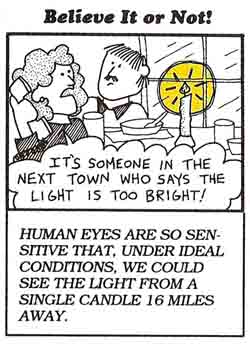 |


